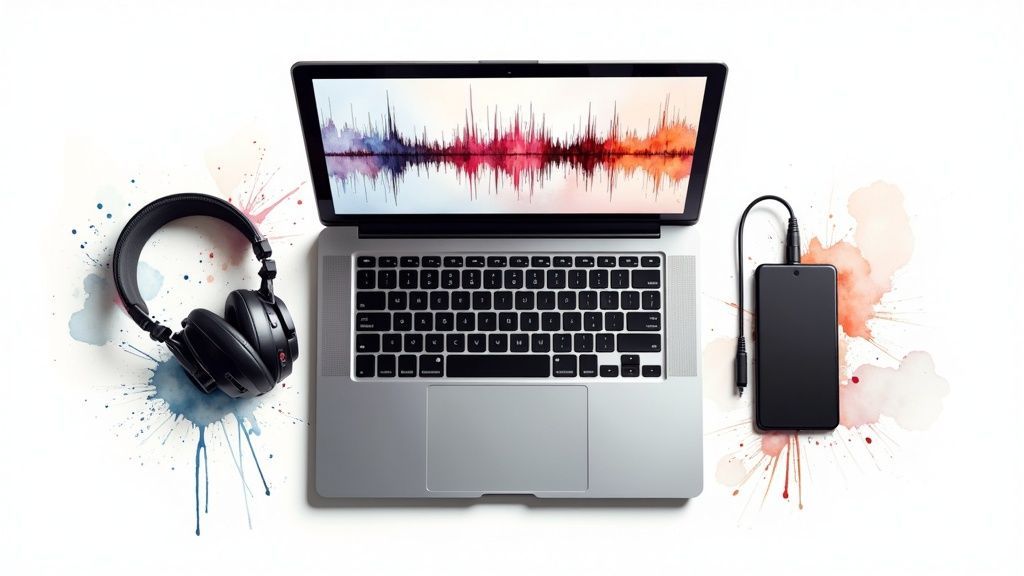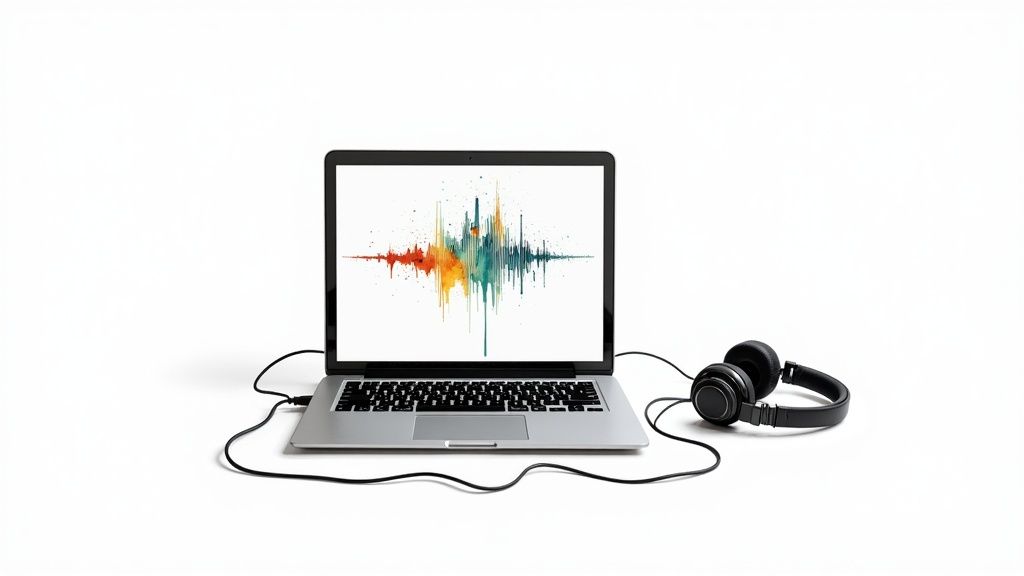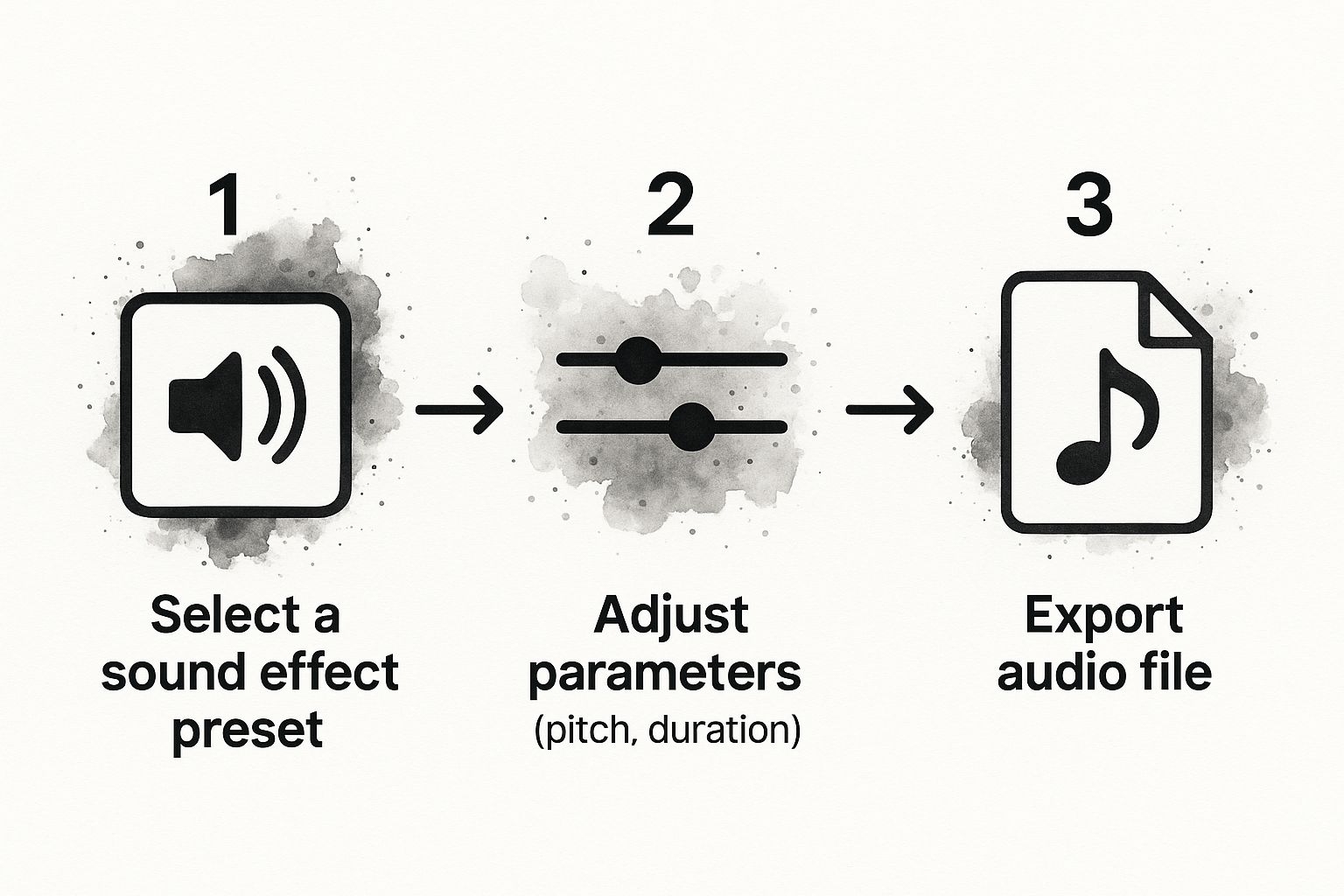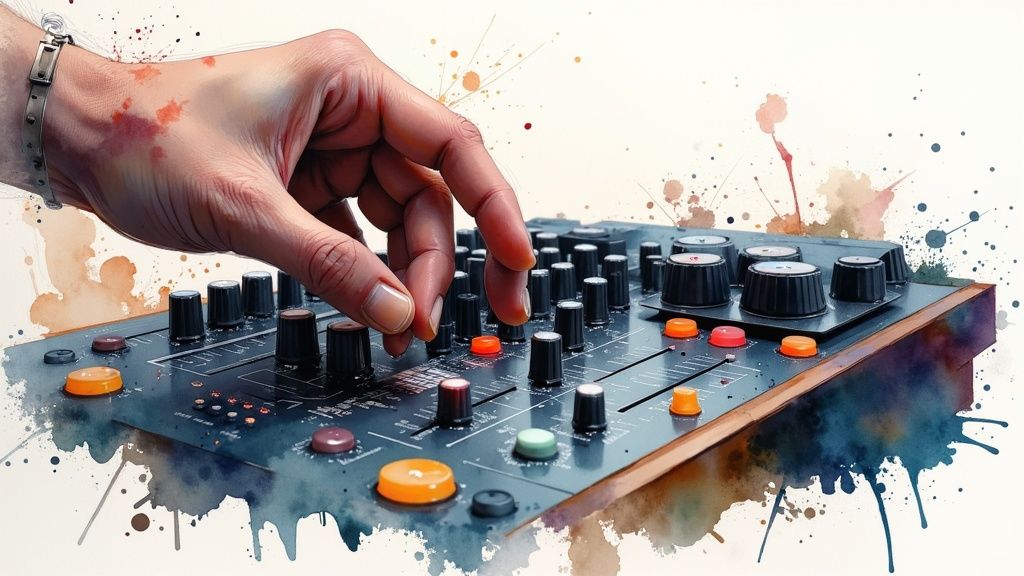
Believe it or not, you can get custom, royalty-free audio for free. Doing so will save you a ton of time, money, and creative headache. A good free sound effect generator has become an indispensable tool for any creator who needs unique, high-quality audio on the fly, without getting bogged down by massive, expensive libraries or copyright concerns. It's a straight-up workflow accelerator that helps your content stand out.

The days of spending hours digging through static sound libraries are thankfully behind us. For years, finding the right audio was a major bottleneck for creators. You’d often have to settle for a generic sound that was close enough but didn't truly match your vision. This process wasn't just tedious; it could get expensive fast, with licensing fees piling up.
An AI-powered free sound effect generator flips the script entirely. Instead of hunting for a pre-made sound, you create the exact audio you need just by describing it. This approach gets rid of creative compromises and opens up a whole new world of possibilities.
Picture this: you're editing a sci-fi video and you need the sound of a "small alien creature chirping curiously inside a crystal cave." Good luck finding that in a standard library. With a generator, you just type that description and get a custom-made effect in seconds.
This shift brings some serious advantages to the table for any creator:
The real game-changer is how it removes the friction between your creative idea and the final product. You can iterate on sounds in real-time, tweaking your prompts until the audio perfectly nails the mood and action of your scene.
Let’s be honest, finding the right sound used to be a real pain. The old way meant sifting through endless files, dealing with complicated licenses, and often paying for sounds that weren't quite right. Modern AI tools change all that.
Here’s a quick look at how the old and new methods stack up.
| Feature | Traditional Sound Libraries | Free AI Sound Effect Generators |
|---|---|---|
| Creation Method | Searching through pre-recorded files | Generating new audio from text prompts |
| Customization | Limited to existing variations | Nearly infinite; tweak until perfect |
| Time Investment | Hours of searching and listening | Seconds or minutes to generate |
| Originality | High risk of using common, overused sounds | Each output is unique to your prompt |
| Cost | Can be expensive (per-file or subscription) | Often free or has generous free tiers |
| Licensing | Can be complex and restrictive | Typically royalty-free for commercial use |
As you can see, the benefits of using a generator are pretty clear, especially when you’re on a deadline or a tight budget.
The growth of these tools is having a huge impact across creative fields. The global AI in music market, which includes this tech, is projected to hit $38.7 billion by 2033, a testament to its rising importance. You can learn more about how AI is reshaping the audio world in our guide on the best free AI audio generator. These tools have become essential for streamlining workflows and pushing creative boundaries.
Looking at that empty text box in a free sound effect generator can be a little intimidating. It’s a lot like staring at a blank page. What do you type? How do you get the sound you're hearing in your head out into the real world?
Let’s walk through a common scenario. Say you’re editing a short fantasy film. You need a very specific "magical swoosh" for a scene where a wizard casts a spell, but nothing in your existing sound library feels quite right. This is where you get to play sound designer.
Instead of just typing "magic sound," think about the qualities of that sound. What does this spell feel like? Is it a light, shimmering effect, or a dark, heavy one? Does it have a trailing echo? Are there little sparks of energy? A much better prompt would be something like: "a shimmering magical spell being cast with a gentle whoosh and sparkling chimes."
See the difference? That detailed description gives the AI distinct elements to work with—the shimmer, the motion (whoosh), and the texture (chimes)—which it can then weave into a single, cohesive sound effect.
Once you hit "generate," you’ll get your first take. Think of this as your starting point, not the finished product. The real magic happens when you start tweaking and refining that initial sound using the tools available.
Most generators, including our own SFX Engine, give you control over the core characteristics of the audio. If you want to go really deep on this, we've got a full guide on how to create sounds that covers the entire creative process.
For our "magical swoosh" example, here’s how you might fine-tune it:
It's really an iterative process. You generate a base sound, adjust the details, and repeat until it's just right.

The key is to experiment. Don't be afraid to push the sliders around and see what happens. Sometimes the best results come from happy accidents.
My biggest piece of advice is to treat the generator like a creative collaborator. Give it a clear, descriptive prompt to start with. Then, use the adjustment tools to sculpt the audio until it perfectly matches your vision.
Even small changes to your prompt can have a huge impact. Swapping "gentle whoosh" for "aggressive roar" in our original prompt would instantly transform the sound from an ethereal spell into a threatening one. This is what makes a good free sound effect generator so valuable—it gives you the power to create a whole library of unique, high-quality audio tailored perfectly to your projects.
 The secret to getting the most out of any free sound effect generator isn't in the tool itself, but in the quality of your prompts. To unlock its true potential, you have to stop making simple requests and start thinking like a sound designer. It’s all about translating the specific audio you hear in your head into descriptive language the AI can actually work with.
The secret to getting the most out of any free sound effect generator isn't in the tool itself, but in the quality of your prompts. To unlock its true potential, you have to stop making simple requests and start thinking like a sound designer. It’s all about translating the specific audio you hear in your head into descriptive language the AI can actually work with.
This means getting incredibly specific. A generic prompt like "door sound" will give you just that—a generic sound. But what if you describe the scene? Try something like, "a heavy oak door groaning open on rusty hinges in a dusty crypt." Suddenly, the AI has real context to build from: the material (oak), the action (groaning), the condition (rusty), and the environment (crypt). Every detail you add gives the final sound effect another layer of authenticity.
The real magic happens when you combine descriptive adjectives with very specific actions. This approach gives the generator a much richer palette to draw from, which is how you get those nuanced and believable audio clips.
Let's look at a few before-and-after examples:
Instead of: "Car sound"
Try: "A vintage muscle car engine sputtering to life before revving aggressively."
Instead of: "Spaceship sound"
Try: "The soft, low hiss of a futuristic spaceship airlock depressurizing."
Instead of: "Wolf sound"
Try: "The distant, mournful howl of a lone wolf in a snowy, silent forest."
See the difference? The second prompt in each example paints a complete scene, not just an isolated object. This results in audio that feels grounded and immersive. Since these generators rely on AI, using tools like AI for brainstorming can be a great way to come up with these more creative and effective prompts.
Don't hesitate to get creative by stacking multiple ideas or even using words that sound like the noise you want. Onomatopoeia can be a fantastic shortcut for communicating texture and timing directly to the AI.
Your prompt is a recipe. The more specific your ingredients—the adjectives, verbs, materials, and environments—the more likely you are to create the exact sound you imagined.
Think about layering different audio concepts within a single prompt to create something more complex. This is how you go from a basic noise to a complete mini-soundscape.
Prompt Layering Examples:
Mastering this iterative process of refining your prompts is what will take you from a casual user to an expert. By learning to describe audio with this level of precision, you give the free sound effect generator everything it needs to produce truly custom sounds for your projects.
Once you get the hang of generating individual sound effects, the real fun begins. This is where you graduate from making isolated noises to truly building entire worlds with sound. Your free sound effect generator stops being just a simple tool and becomes your personal sound design studio.
The secret? It's all about thinking in layers. Think about it—almost nowhere in the real world do you hear just one sound at a time. A busy city street isn't just generic "car noise." It's a complex tapestry woven from distant sirens, the rhythmic shuffle of footsteps on pavement, the low hum of building HVAC systems, and snippets of conversation you can't quite make out. Layering these distinct sounds is how you create an audio environment that feels real and pulls your audience in.
Let's walk through a practical example: creating a realistic city rainstorm from the ground up. Instead of a single, generic prompt like "city rain," we'll generate a few key components and then mix them together in our editing software.
Here’s a simple recipe I often use:
When you combine these three separate tracks, you're in complete control. You can tweak the volume of each layer, bringing the splashing cars forward or pushing the thunder further into the background to craft a much more dynamic and believable experience.
To really nail this, having a good grasp of the basic concept of an audio clip is crucial. These clips are the fundamental building blocks you'll be working with.
I like to think of building a soundscape like painting a picture. Each sound effect is a different color on your palette. By carefully blending them, you create a scene with a depth, texture, and emotional weight that a single, flat sound could never capture.
This layering technique used to be the exclusive domain of professional sound designers, but now it’s something anyone can do. It's a powerful way to make your projects sound incredibly professional.

Creating your own sounds with a free sound effect generator is incredibly powerful, but you've got to understand the licensing to use them without getting into trouble later. The key term you'll run into is royalty-free, and for creators, it’s a game-changer.
So, what does it actually mean? Royalty-free means you get the right to use the sound effect after a one-time process—in our case, just by generating it. You don't have to pay recurring fees or royalties every time someone watches your video or plays your game. This is a huge relief, especially for projects on YouTube, Twitch, or any commercial release.
Most AI sound generators, including SFX Engine, give you a pretty broad commercial license. This means you’re generally cleared to use your custom audio in a ton of places.
You can confidently bake these sounds into:
The bottom line is this: once you've generated the sound, it's yours to use in your creative work. You won't have to look over your shoulder, worrying about copyright claims or takedown notices down the road. Still, it's always a smart habit to glance at the specific terms of service, as some edge cases might require attribution.
If your project involves mixing your generated sounds with audio from other sources, licensing becomes even more critical. For instance, if you're pulling audio from existing videos, knowing how to use a YouTube audio extractor safely and legally is essential.
Diving into a new tool always brings up a few questions. I've been there. To help you get up and running smoothly, I’ve pulled together some of the most common queries I hear about using AI sound generators.
For the most part, yes—and it's a huge advantage. When you generate a sound with a platform like SFX Engine, it's typically royalty-free. That means you can drop it right into your YouTube videos, podcasts, or indie games without worrying about paying fees down the line.
That said, it's always a good habit to glance at the terms of service for any tool you're using. Some platforms might have specific rules or ask for attribution, so a quick check saves you any headaches later.
Don't worry, this happens all the time. Think of it less as a failure and more as part of the creative discovery process. The trick is to refine your prompt.
If you started with something generic like "explosion," try getting more specific. What kind of explosion is it? Where is it happening? A better prompt might be, "a muffled, distant explosion followed by the sound of falling debris." The more detail you feed the AI, the closer it gets to your vision.
My best advice? Don't stop at one generation. Create a handful of variations by tweaking your prompt slightly. Sometimes just changing one adjective or adding a detail about the environment is all it takes to get that perfect sound.
Absolutely! Once you download the audio file—usually as a WAV or MP3—it’s all yours to play with.
You can pull it into any audio or video editor you're comfortable with. From there, you have complete creative freedom to:
This gives you the flexibility to seamlessly blend the generated sound into your project.
Ready to stop searching and start creating? Give SFX Engine a try and see what unique audio you can bring to life in just a few seconds. Start generating your custom sound effects today.